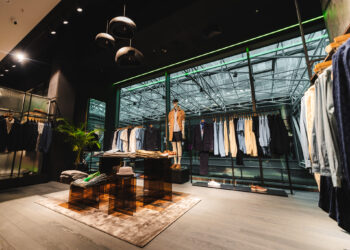Are you tired of compromising on either quality or affordability when it comes to fashion? Look no further, because Everlane is here to break the mold and redefine the standards of the industry. In this blog post, we will delve into how Everlane has revolutionized the way we perceive fashion by offering high-quality products at affordable prices – a truly irresistible combination. Get ready to discover how this brand has transformed our shopping experience and made us rethink what it means to dress well without breaking the bank.
Introduction to Everlane
Everlane is a clothing brand that has been making waves in the fashion industry with its mission to provide high-quality, ethically-made garments at affordable prices. The company was founded in 2010 by Michael Preysman, who wanted to change the way people think about and purchase clothes.
The mission of Everlane is rooted in transparency and sustainability. They believe that customers have the right to know where their clothes come from, how they are made, and what impact they have on the environment. This commitment to transparency is evident through their “radical transparency” policy, which includes providing information such as factory costs, markups, and even the true cost of each product.
How Everlane is breaking the mold with ethical and sustainable production practices
Everlane has been making waves in the fashion industry with its commitment to ethical and sustainable production practices. While fast fashion brands continue to dominate the market, Everlane is breaking the mold by prioritizing not only fashionable designs, but also ethical and sustainable production processes.
One of the ways Everlane is redefining quality and affordability in fashion is through transparent pricing. The brand breaks down the cost of each item on their website, from materials and labor to transportation and duties. This level of transparency is uncommon in the fashion industry, where hidden markups are often added onto products. By being open about their expenses, Everlane ensures that customers are getting fair prices for high-quality products.
In addition to transparent pricing, Everlane also emphasizes ethical working conditions for all employees involved in the production of their garments. The brand works with factories around the world that prioritize fair wages, reasonable working hours, and safe working environments for their employees. To ensure these standards are being met, Everlane regularly visits their factories and shares reports on working conditions with customers.
But it’s not just about treating workers fairly – Everlane also takes into consideration the environmental impact of its production processes. The brand uses a variety of sustainable materials such as organic cotton, recycled polyester, and Tencel (a fabric made from sustainably sourced wood pulp). They also work towards reducing waste by using leftover materials for future collections or repurposing them into other items like face masks.
Everlane’s commitment to sustainability goes beyond just using eco -friendly materials. The brand also focuses on reducing their carbon footprint through innovative practices, such as using renewable energy sources and carbon offsetting. They also offer a “Carbon Neutral” shipping option for customers, where Everlane will offset the emissions from the delivery of their order.
In addition to ethical and sustainable production practices, Everlane is also dedicated to creating timeless and versatile pieces that encourage customers to buy less, but better. Through their “Choose What You Pay” sales model, they give customers the option to choose between three different prices for an item – each price representing a different stage in the production process. This not only allows customers to see the true cost of their garments, but it also encourages them to think about the value of clothing and make more intentional purchases.
Everlane’s commitment to transparency, sustainability, and fair working conditions has gained them a loyal customer base who value these principles in their fashion choices. By breaking away from traditional fast fashion practices and setting higher standards for themselves and the industry as a whole, Everlane is proving that ethical and sustainable fashion can be both stylish and accessible.
Quality vs. affordability: Can you really have both?
Quality and affordability are two key factors that consumers often consider when making purchases, especially in the world of fashion. Many people believe that these two elements are mutually exclusive – that you can only have one or the other. However, Everlane has proven this wrong with their unique business model that prioritizes both quality and affordability.
Traditionally, luxury brands have been associated with high-quality products while fast fashion retailers have been known for offering affordable but lower quality items. However, with the rise of conscious consumerism and the demand for sustainable and ethical practices in the fashion industry, there has been a shift towards prioritizing quality over quantity.
This is where Everlane comes in – disrupting the traditional retail model by offering high-quality, ethically-made products at an affordable price point. They achieve this by cutting out middlemen and selling directly to consumers through their online platform. This direct-to-consumer approach allows them to keep costs low without compromising on quality.
One of Everlane’s key strategies is transparency. They believe in providing customers with all the information about their products – from production costs to materials used – so that they can make informed purchasing decisions. By being transparent about their pricing structure, customers can see exactly what they’re paying for without any hidden markups.
In terms of quality, Everlane takes a “less is more” approach. They focus on creating timeless pieces using high-quality materials that will last beyond just one season. This means less waste and more value for money for customers. In addition to this, Everlane also ensures ethical production practices by partnering with factories that are transparent about their sourcing and pay their employees fair wages.
So, can you really have both quality and affordability? Everlane’s success has proven that it is possible. By prioritizing transparency, ethical practices, and a direct-to-consumer model, they have become a leader in the industry for offering high-quality products at reasonable prices. They have also set a standard for other retailers to follow suit and prioritize sustainable and ethical practices without compromising on affordability.
A closer look at Everlane’s transparent pricing model and factory partnerships
Everlane’s commitment to transparency goes beyond just talking about it – they have implemented a revolutionary pricing model that allows customers to see exactly what they are paying for when purchasing their products. Unlike most fashion retailers, Everlane breaks down the cost of each item on their website, providing customers with a detailed breakdown of materials, labor, and transportation expenses.
This level of transparency not only allows customers to understand the true value of the product they are buying but also sheds light on the often hidden costs associated with producing clothing. By revealing these details, Everlane is holding themselves accountable for fair pricing and ensuring that workers in their factories are being paid a fair wage.
Not only does Everlane provide transparent pricing information for each product on their website, but they also disclose where their factories are located. Customers can click on the “Factories” tab on Everlane’s website and see a list of every factory that produces their clothing along with photos and details about working conditions.
This unique approach to pricing has not gone unnoticed – it has gained praise from ethical fashion advocates and consumers alike. The brand’s commitment to transparent pricing aligns with its overall mission of making quality clothing without compromising on affordability. This pricing model also sets a standard within the fashion industry, encouraging other brands to follow suit.
Furthermore, Everlane takes great care in selecting their factory partners by assessing them based on several criteria such as fair wages, workplace safety measures, hours worked, and environmental impact. The brand follows strict guidelines set forth by various international labor organizations and conducts regular audits to ensure that their factories are meeting these standards.
Through their transparent pricing model and commitment to ethical production, Everlane is setting a new standard for the fashion industry. By providing customers with information about the true cost of their clothing and the conditions in which it was made, Everlane is empowering consumers to make more informed purchasing decisions.
Everlane’s impact on the fashion industry and its competitors
Everlane has quickly become a household name in the fashion industry, known for its high quality and affordable clothing. But beyond that, this brand has also made a significant impact on the entire fashion landscape and its competitors.
When Everlane first burst onto the scene in 2010, it brought with it a transparent approach to production and pricing that was virtually unheard of in the fashion world. By exposing the true costs behind each garment and eliminating traditional retail markups, Everlane offered consumers an unparalleled level of insight into their supply chain and pricing strategies.
This level of transparency not only appealed to customers who were becoming increasingly conscious about ethical and sustainable fashion practices, but it also put pressure on other brands to be more open about their own production processes. As a result, many companies have since adopted similar transparency models, which is changing the overall standard for accountability within the industry.
In addition to promoting more responsible business practices, Everlane also disrupted the traditional seasonal calendar followed by most retailers. Instead of releasing new collections every few months, Everlane operates on a “drop” system – releasing limited quantities of new styles throughout the year.
This approach not only creates a sense of urgency for customers to purchase items before they sell out, but it also decreases waste and promotes sustainability by reducing overproduction. This departure from seasonal collections has prompted several other brands to follow suit or at least consider adopting a similar model.
Furthermore, Everlane’s focus on timeless designs rather than trendy pieces sets them apart from many fast-fashion competitors . By offering well-made, versatile clothing that can be worn for years instead of just one season, Everlane is encouraging customers to shop more consciously and invest in pieces that will last.
Overall, Everlane’s impact on the fashion industry has challenged the status quo and forced its competitors to take notice. By prioritizing transparency, sustainability, and longevity over traditional retail practices, this brand has helped shift the industry towards a more responsible and ethical approach.
Conclusion
In today’s fast-paced and ever-changing fashion industry, Everlane stands out as a company that breaks the mold. With their commitment to transparency, sustainability, quality, and affordability, they have redefined what it means to be a successful fashion brand. By choosing Everlane products, not only are you getting stylish and well-made pieces for your wardrobe but also supporting a company with values that align with today’s conscious consumers. It’s time to break away from the traditional fast-fashion cycle and join Everlane in creating a more sustainable and ethical future of fashion.









